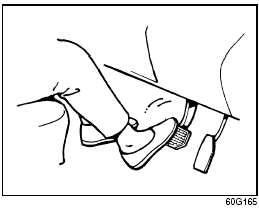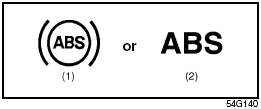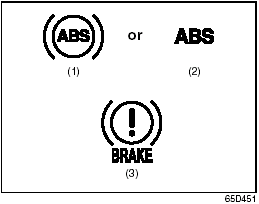 Suzuki Grand Vitara: Braking
Suzuki Grand Vitara: Braking

Braking
The distance needed to bring any vehicle to a halt increases with the speed of the vehicle. The braking distance needed, for example, at 60 km/h (37 mph) will be approximately 4 times greater than the braking distance needed at 30 km/h (19 mph). Start to brake the vehicle when there is plenty of distance between your vehicle and the stopping point, and slow down gradually.
 WARNING: If water gets into the
brake drums, brake performance may become poor and unpredictable. After driving
through water or washing the underside of the vehicle, test the brakes while driving
at a slow speed to see if they have maintained their normal effectiveness. If the
brakes are less effective than normal, dry them by repeatedly applying the brakes
while driving slowly until the brakes have regained their normal effectiveness.
WARNING: If water gets into the
brake drums, brake performance may become poor and unpredictable. After driving
through water or washing the underside of the vehicle, test the brakes while driving
at a slow speed to see if they have maintained their normal effectiveness. If the
brakes are less effective than normal, dry them by repeatedly applying the brakes
while driving slowly until the brakes have regained their normal effectiveness.
Power Assisted Brakes
Your vehicle has power assisted brakes. If power assistance is lost due to a stalled engine or other failures, the system is still fully operational on reserve power and you can bring the vehicle to a complete stop by pressing the brake pedal once and holding it down. The reserve power is partly used up when you depress the brake pedal and reduces each time the pedal is pressed. Apply smooth and even pressure to the pedal. Do not pump the pedal.
 WARNING: Even without reserve
power in the brake system, you can still stop the vehicle by pressing the brake
pedal harder than normally required. However, the stopping distance may be longer.
WARNING: Even without reserve
power in the brake system, you can still stop the vehicle by pressing the brake
pedal harder than normally required. However, the stopping distance may be longer.
Brake Assist System
When you slam the brakes on, the brake assist system judges as an emergency stop and provides more powerful braking for a driver who cannot hold down the brake pedal firmly.
NOTE: If you depress the brakes forcefully, you may hear a clicking sound in the brake pedal. This is normal and indicates that the brake assist system is activated properly.
Anti-Lock Brake System (ABS)
ABS will help you avoid skidding by electronically controlling braking pressure. It will also help you maintain steering control when braking on slippery surfaces or when braking hard. The ABS works automatically, so you do not need any special braking technique. Just push the brake pedal down without pumping. The ABS will operate whenever it senses that the wheels are locking up. You may feel the brake pedal pulsate while the ABS is operating.
NOTE: The ABS will not work if vehicle speed is under 5 – 6 km/h (3 – 4 mph).
 WARNING:
WARNING:
• On some types of loose surfaces (such as gravel, snow-covered roads, etc.), the
stopping distance required for an ABS-equipped vehicle may be slightly greater than
for a comparable vehicle with a conventional brake system. With a conventional brake
system, skidding tires are able to “plow” the gravel or snow layer, shortening the
stopping distance. ABS minimizes this resistance effect. Allow for extra stopping
distance when driving on loose surfaces.
• On regular paved roads, some drivers may be able to obtain slightly shorter stopping
distances with conventional brake systems than with ABS.
• In both of the above conditions, ABS will still offer the advantage of helping
you maintain directional control. However, remember that ABS will not compensate
for bad road or weather conditions or poor driver judgment. Use good judgment and
do not drive faster than conditions will safely allow.

 WARNING: If the ABS warning light
((1) or (2)) on the instrument panel comes on and stays on while driving, there
may be a problem with the ABS system. If this happens: 1) Pull off the road and
stop carefully. 2) Turn the ignition switch to “LOCK” and then start the engine
again. If the warning light comes on briefly then turns off, the system is normal.
If the warning light still stays on, have the system inspected by your SUZUKI dealer
immediately. If the ABS system becomes inoperative, the brake system will function
as an ordinary brake system that has no ABS.
WARNING: If the ABS warning light
((1) or (2)) on the instrument panel comes on and stays on while driving, there
may be a problem with the ABS system. If this happens: 1) Pull off the road and
stop carefully. 2) Turn the ignition switch to “LOCK” and then start the engine
again. If the warning light comes on briefly then turns off, the system is normal.
If the warning light still stays on, have the system inspected by your SUZUKI dealer
immediately. If the ABS system becomes inoperative, the brake system will function
as an ordinary brake system that has no ABS.

 WARNING: If the ABS warning light
((1) or (2)) and the Brake system warning light (3) on the instrument panel simultaneously
stay on or come on when driving, both anti-lock function and rear brake force control
function (Proportioning valve function) of the ABS system may have failed. This
could cause the rear wheels to skid or the vehicle to spin during braking on a slippery
road or hard braking on a dry paved road. If both warning lights come on, drive
carefully, avoiding hard braking as much as possible, and ask your SUZUKI dealer
to inspect the ABS system immediately.
WARNING: If the ABS warning light
((1) or (2)) and the Brake system warning light (3) on the instrument panel simultaneously
stay on or come on when driving, both anti-lock function and rear brake force control
function (Proportioning valve function) of the ABS system may have failed. This
could cause the rear wheels to skid or the vehicle to spin during braking on a slippery
road or hard braking on a dry paved road. If both warning lights come on, drive
carefully, avoiding hard braking as much as possible, and ask your SUZUKI dealer
to inspect the ABS system immediately.
How the ABS Works
A computer continuously monitors wheel speed. The computer compares the changes in wheel speed when braking. If the wheels slow suddenly, indicating a skidding situation, the computer will change braking pressure several times each second to prevent the wheels from locking. When you start your vehicle or when you accelerate after a hard stop, you may hear a momentary motor or clicking sound as the system resets or checks itself.
 WARNING: The ABS may not work
properly if tires or wheels other than those specified in the owner’s manual are
used. This is because the ABS works by comparing changes in wheel speed. When replacing
tires or wheels, use only the size and type specified in this owner’s manual.
WARNING: The ABS may not work
properly if tires or wheels other than those specified in the owner’s manual are
used. This is because the ABS works by comparing changes in wheel speed. When replacing
tires or wheels, use only the size and type specified in this owner’s manual.
 Using the Transfer Switch (if equipped)
Using the Transfer Switch (if equipped)
Using the Transfer
Switch (if equipped)
Your vehicle is equipped with a four-mode full-time 4x4 system. You can use the
transfer switch to select any of the four modes: N, 4H, 4H LOCK, 4L LOCK.
...
 Electronic Stability Program (ESP®)
Electronic Stability Program (ESP®)
ESP® is a registered trademark of DaimlerChrysler AG. The Electronic Stability
Program (ESP®) helps to control the vehicle during cornering if the vehicle is understeering
or oversteering. It al ...
See also:
Meter needles/gauge illumination setting (models with type A combination
meter)
When the setting is activated or deactivated,
the meter needles and gauge
illuminate and turn off as follows.
Activated:
When the driver’s door is opened while
the ignition switch is in the ...
Keyless drive information messages
If all of the PCCs are removed from the vehicle
while the engine is running or if the ignition is
in mode II (see page 82) and all of the doors
are closed, a message will appear in the instrumen ...
Adding engine oil
1. Check the engine oil. For instructions, refer to Checking the engine
oil in this chapter.
2. If the engine oil level is not within the normal range, add only certified
engine oil of the recommen ...
